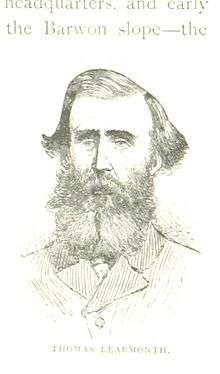Thomas Livingstone Learmonth
| Thomas Livingstone Learmonth | |
|---|---|
 An 1888 illustration of Learmonth | |
| Born | 1818 |
| Died | 1903 |
| Spouse(s) |
Louisa Jane Florence Harriett |
| Parent(s) |
|
| Relatives | Somerville Learmonth (brother) |
Thomas Livingstone Learmonth (1818-1903) was an early Victorian settler who established land around Ballarat, Victoria.
Learmonth was the son of Thomas Learmonth, a well-known settler in Tasmania, and was born in 1818. Having been attracted to the new settlement at Port Phillip, he started with a pioneering party from the shores of Corio Bay, in August 1837, to explore the unknown country to the north-west, directing their course, in the first instance, to Mount Buninyong, near to which, in conjunction with his brother, Somerville Livingstone Learmonth, Mr. T. L. Learmonth subsequently entered on pastoral pursuits on the fine country the party then discovered farther to the north-west. In the following year the two brothers and some friends explored the course of the Loddon, and reached a prominent peak, which they afterwards called Ercildoune, from an old keep on the Scottish border associated with their ancestral history. Here the brothers established a second station. After many years of prosperity the Messrs. Learmonth disposed of their Buninyong property, and subsequently sold the famous Ercildoune estate to Sir Samuel Wilson. Mr. Learmonth was for some time a member of the Upper House in Victoria, and finally left for England in 1868. Mr. Learmonth, later lived at Park Hall, Polmont, N.B., and was a J. P. for Stirlingshire, married, firstly, in 1857, Louisa, daughter of Major-General Sir Thomas Valiant, who died in 1878; and, secondly, in 1879, Jane Florence Harriett, daughter of Lestock Reid, of the Bombay Civil Service.[1] He died in 1903.
References
- ↑ Mennell, Philip (1892). "
 Learmonth, Thomas Livingstone". The Dictionary of Australasian Biography. London: Hutchinson & Co. Wikisource
Learmonth, Thomas Livingstone". The Dictionary of Australasian Biography. London: Hutchinson & Co. Wikisource